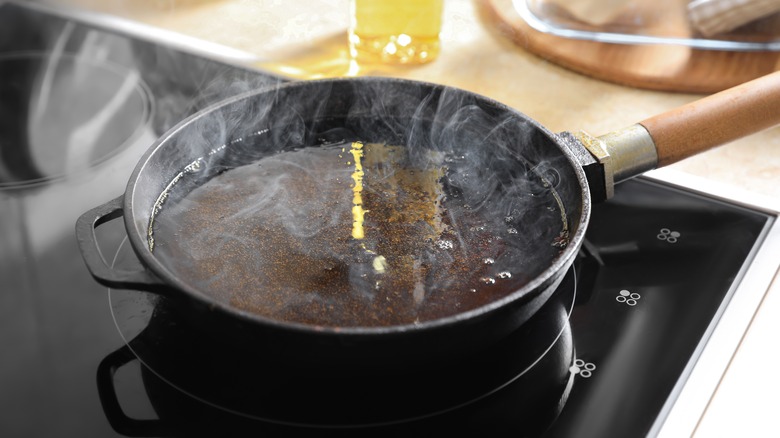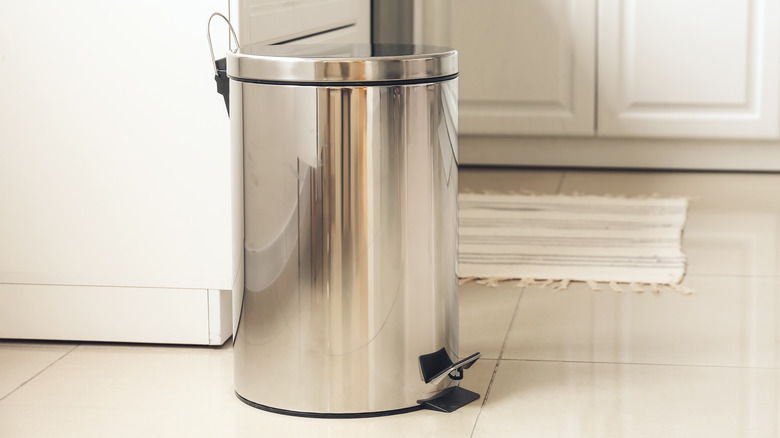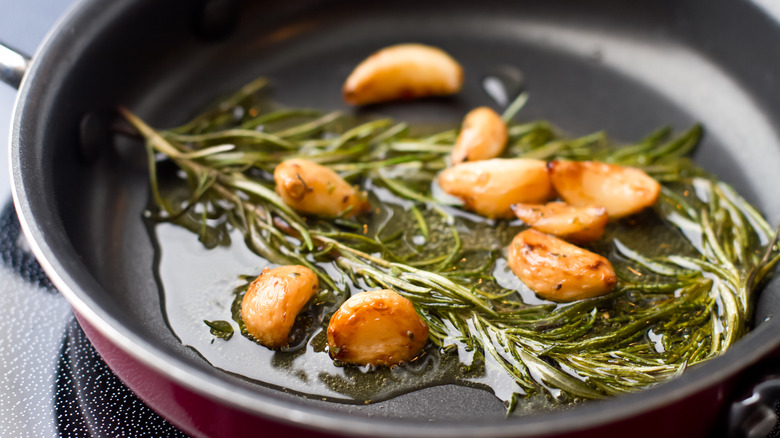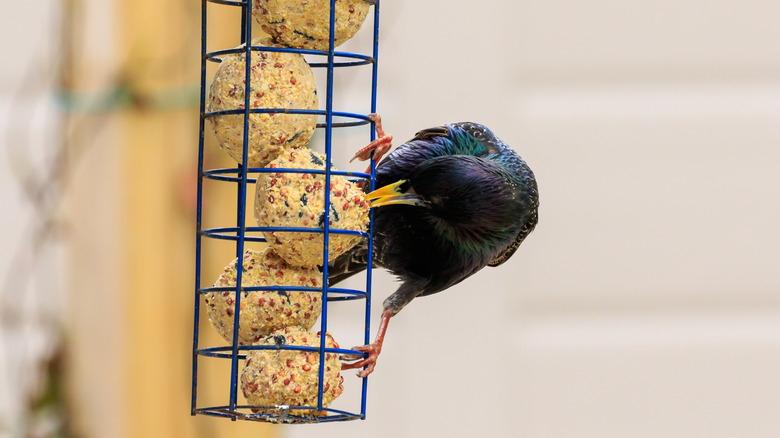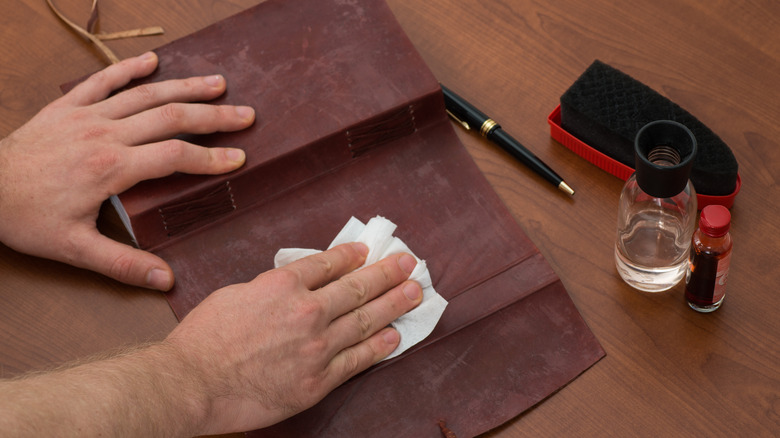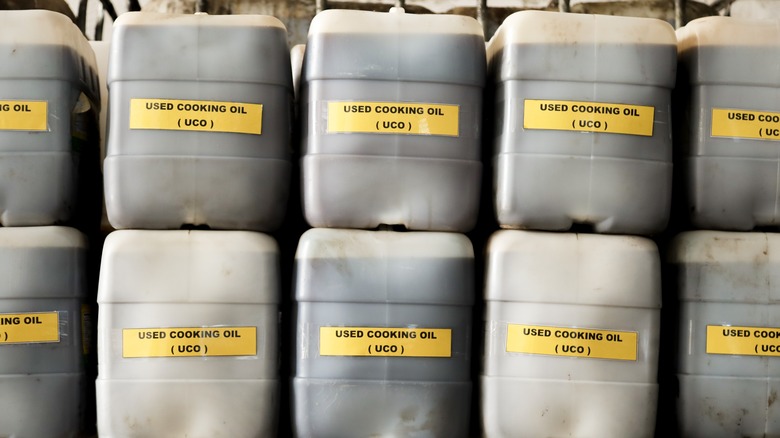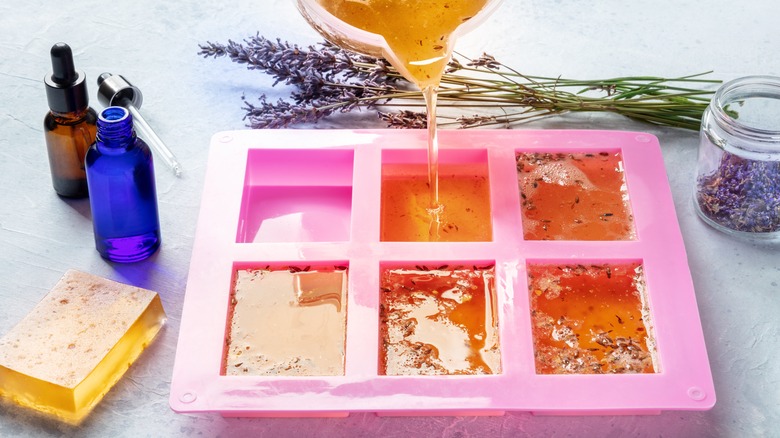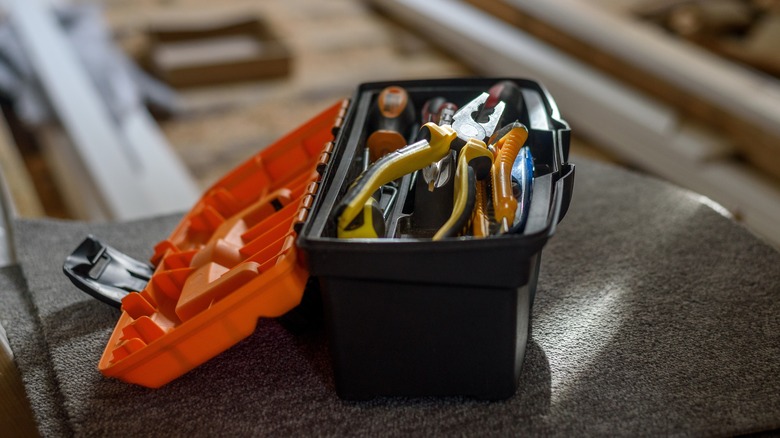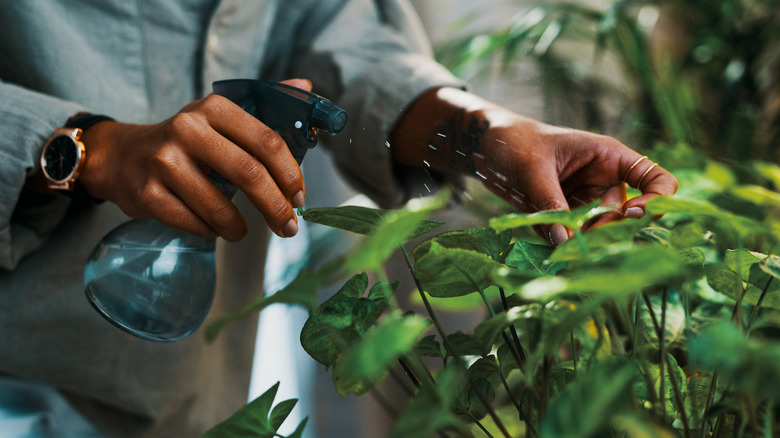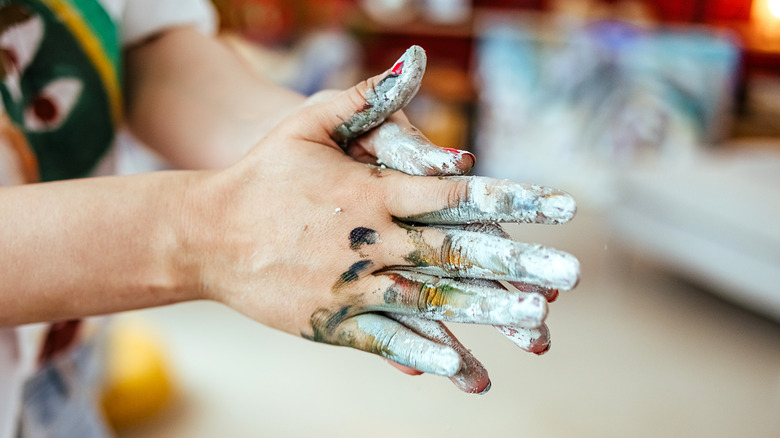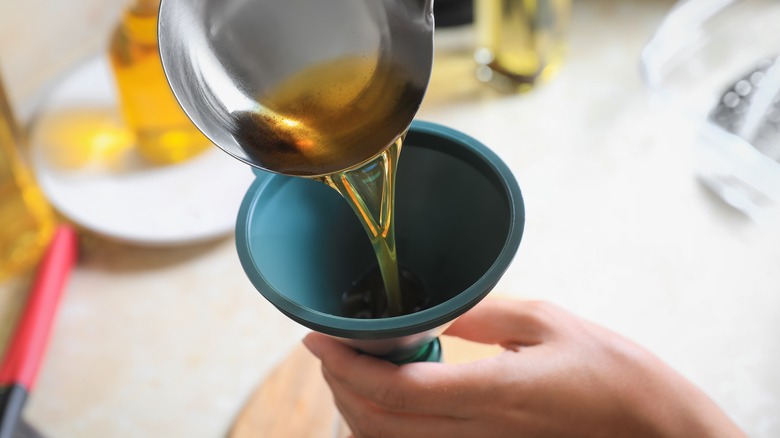11 Actually Reasonable Ways To Dispose Of Cooking Oil
Pretty much everyone uses oil to cook from time to time. Unfortunately, while fried foods are almost always delicious, cleaning up afterward can be difficult. Not only do you have to deal with oil splatters on your kitchen counter, but you also have to consider how you're going to dispose of your cooking oil. You can't just pour it down the drain or flush it down the toilet. Its greasy, sticky nature will make other waste particles attach to it, causing blockages or even an aptly named — but very damaging and difficult-to-remove — fatberg. Even if the oil does make it past your pipes and local sewer system, it can ultimately damage flora and fauna.
Fortunately, there are a few ways to properly dispose of cooking oil, but you might be surprised to learn that you can reuse it, as well. Whether for cooking, household maintenance, or even self-care and creative projects, here are 11 things you can do with your cooking oil that won't hurt your plumbing. They're also safe for the environment — in some cases, they might even help it!
1. Throw it in the trash
Since you can't dispose of cooking oil by pouring it down the sink or toilet, throwing it in the trash seems like the most reasonable option. If you have napkins or other disposable items with a bit of oil on them, this is a super simple solution. When the time comes to dispose of the rest of your oil, however, matters get a bit more complicated.
Pouring liquid in the trash is far from neat and easy. Most people solve this problem by waiting until their cooking oil has cooled and then pouring it into some kind of sealed, water-tight container that they were going to toss anyway, like a jar or plastic bottle. An old Tupperware container will also do the trick, or even (if you're desperate) a soda can, although with this method, you do risk oil leaking out of the top. If you don't have any of these, try a carefully knotted plastic bag or, better yet, a Ziplock.
2. Reuse it to cook another meal
You may be able to reuse your cooking oil for another meal or two, under certain conditions. Some cooking oils break down more quickly than others and can't be reused. Once oil is heated to its smoke point, it changes on a molecular level and can create free radicals. These have been linked to conditions like Alzheimer's, as described in this 2001 study published in The Journal of the American Osteopathic Association. Fortunately, if you choose the right cooking oil (i.e., one that doesn't break down easily), you should be fine. While there are exceptions, "safe" oils generally include sunflower, canola, and safflower oil, among others. Regardless of type, ensure that the oil you want to reuse didn't smoke the first time you heated it.
Additionally, you should strain your oil to remove any food or other particles. Otherwise, it can become a breeding ground for harmful bacteria. Another factor to consider is odor. If the oil still retains a smell (like fish, for instance), you probably don't want to reuse it for a different dish. If you can reuse your fry oil, store it in a sealed container in the fridge. The low temperature should help stave off bacteria, but before reusing it, give it a look and a sniff. If it looks cloudy or has a rancid, "off" smell, it's no longer good and should be tossed.
3. Make birdseed balls
Cold weather is tough on birds, especially where food is concerned. The ground might be covered in snow or too hard to dig into in search of worms and bugs. As such, bird lovers often make birdseed balls, also called fat balls. A mixture of seeds and a bird-safe fat source, birdseed balls are a valuable source of food and energy for our avian pals. They're sure to increase the number of feathered friends in your yard, and if you have kids, making these balls can be a fun indoor activity. Conveniently, birdseed balls are also a great way to get rid of leftover cooking oil.
That said, not all oils are safe to use for birdseed balls. The best kinds are coconut oil and sunflower oil. If you've cooked with lard or have suet from leftovers, these can also be used. There are plenty of birdseed ball recipes out there, and in most cases, when you've finished mixing and shaping them, you can keep them in the freezer. When the weather starts turning cold, take out a ball and put it in a suspended feeder (never in a plastic bag or net) or tie a string around it and hang it from a tree. Then get ready for some exciting winter birdwatching!
4. Take it to a restaurant
The average person may not have an easy, accessible way to get rid of cooking oil, but the average restaurant should. Restaurants are equipped with systems that store large amounts of used oil. Once enough is stored up, most establishments will call on specialized waste removal companies to transport and recycle it. If you use a lot of oil in your cooking, this may be something you'll want to get in on.
Some restaurants will help locals dispose of their used cooking oil, but don't just load up your car with dozens of oil-filled bottles and drive to your favorite local eatery. It's best to ask first. If the restaurant doesn't accept oil from individual people, don't be discouraged — another place is likely to say yes. And who knows? Scouting new places to drop off your cooking oil may lead you to a new favorite coffee place or dinner spot.
5. Use it to condition leather
Leather is a beautiful and durable material, but it needs looking after. This includes moisturizing it from time to time. There are plenty of expensive products on the market for this, but you may not have to spend a dime. Although these can't be used on every kind of leather, you can apply vegetable oil or coconut oil to items like furniture, belts, boots, and bags, as long as they're made of vegetable-tanned leather. Of course, keep in mind that the cooking oil you use for this has to be clean and odor-free, so strain it first and check for smells. Rancid oil is also a big no-no.
If your leftover vegetable-based or coconut oil is clean and has no odor, pour a small amount of it onto a cloth. Then, just rub the oil onto a clean leather surface using concentric motions. Don't use too much oil or the leather will become sticky or greasy and will attract dirt. You shouldn't have to reapply oil to leather very often, but when the time comes, it's good to know that you have an inexpensive way to do so. It's also good for the environment since, unlike cooking oil, leather care products often contain chemicals.
6. Take it to a recycling center
Depending on where you live, you might be able to recycle your used cooking oil. The liquid can be recycled into a surprising number of products, from biofuel to pet food additives to cosmetic ingredients. Some communities let residents recycle oil by putting it in a sealed container and leaving it beside their curbside recycling bin. In most cases, however, you'll have to take it to a specialized recycling center. To avoid frequent trips, store your used oil in a closed container and wait until it's full to make the trek. Also worth noting is that oil recycling centers will accept any kind of cooking oil and even butter, and they don't have to be separated.
If this sounds like a good solution to you, research recycling options near you. You may even want to try out online tools like Earth911's recycling locator. If there's no such facility in your area, try contacting your local fire department, which might also collect and dispose of the substance.
7. Make soap or hair conditioner
Used cooking oil can be dirty and messy, but if it's strained and odor-free, you can use it to get clean by turning it into soap! The basic ingredients of homemade soap are water, lye (sometimes called caustic soda or sodium hydroxide), and vegetable oil. You can also add an essential oil of your choice to make it smell nice. It's easy to find soap recipes online, and while the process may take a little work and require molds (as well as a few other supplies), it can be a fun project that will result in something you'll actually use or give away as a gift.
You can also use cooking oil in some hair conditioning or moisturizing treatments. As with soap, make sure that your used cooking oil is clean, odor-free, and not rancid. From there, just choose from the countless oil-based hair treatment recipes and techniques that you can find online. The simplest use for these mixtures entails massaging them into your hair and scalp and then rinsing them out after 10-15 minutes.
8. Lubricate metal hinges and hand tools
If your door's creaky hinges are driving you crazy or your once-trusty hand tools are getting a little harder to use, cooking oil is the answer. It's an accessible, inexpensive resource that can bring practically any tool — and any hinges — back to life. As always, make sure you strain and sniff-test your oil before using it.
To lubricate hinges, apply a few drops of oil, but not so much that it runs. Not only will this make a mess, but using too much could block the hinge or create buildup that prevents it from moving. Many professionals advise applying it with an eyedropper or pipette. When lubricating a metal tool, the same idea applies: Avoid using too much oil. You can always add more, but too much will make a mess and may make your tool even less effective. For this task, use a spray bottle to lightly cover all of your tool's metal areas, then just wipe away any residue to prevent rust. While cooking oil can be used on hinges and hand tools, keep it away from power tools — those require specific types of lubricant.
9. Make an eco-friendly pesticide
The insecticides you buy at the store are filed with chemicals that can harm other insects and wildlife — they may even pose a risk to your kids or pets. Fortunately, there are several different kinds of chemical-free pesticides you can make at home. One popular variety is a mixture of cooking oil, soap, and water. Instructions for making it are widely available online. The ingredient amounts may vary slightly depending on where you source your recipe from, but the basic components remain the same.
Once you've made it, you can spray this eco-friendly pesticide on plants that are infested with mites or aphids. The oil will cover their bodies and block their pores, which is lethal to insects, as they use their pores to breathe. As with most of the tips on this list, make sure your used cooking oil has been strained and is as clean as possible before using it.
10. Use it as paint remover
Whether you paint often or are just starting your first big DIY project, used cooking oil will come in handy, as long as it's odor-free and properly strained, of course. Spilled or splattered paint — or even just leftover spots on your hands — can feel like a disaster, but in some cases, cooking oil can loosen it and make it easy to wash off. For instance, if your hands accidentally become covered in paint, try coating them in oil, waiting five minutes, and washing them off.
Another fairly simple fix is using old cooking oil to remove paint from plastic. Just put some on a cloth and rub it into the paint stain until it completely disappears. Alternatively, if your paint has stained leather, use olive oil to get it out. If left to sit on the stain for a while, the oil will soften the paint and make it easier to remove.
11. Use an oil solidifier
Maybe there isn't an oil recycling center near you, or maybe you feel bad about putting your leftover oil in a container and throwing it in the trash when the container could have been recycled with the rest of your plastics and glass. Fortunately, there's another solution for safely throwing away cooking oil: making it a solid.
To do so, make sure the oil is cool and then refrigerate or freeze it. Another option is to use a cooking oil solidifier. These are widely available online, and many of them are composed of eco-friendly ingredients. The solidifiers should only take around 20 minutes to transform a small amount of oil into a gooey pile or disk that you can then scoop directly into the trash, though the process will take longer the more oil you have.
These solidifiers can be pricey, but there are more budget-friendly solutions. Available online and in some stores, stearic acid can also solidify oil. Just a few tablespoons in still-hot cooking oil will set the solidifying process in motion. Another way to accomplish this is to mix the oil with gelatin that's been heated in water before putting the mixture in the refrigerator. Interestingly, this process separates the clean oil from the dirty, so you may even be able to scoop out the clean oil and reuse it!
